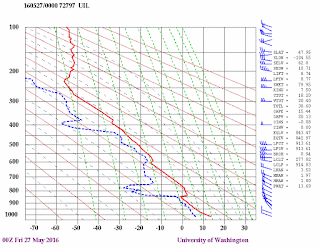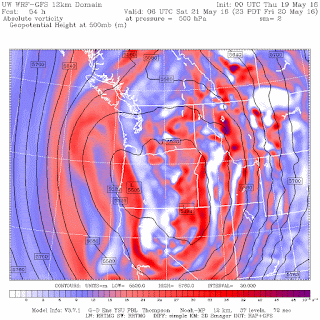Last summer three wildland firefighers died near Twisp, Washington as wind reversed during the afternoon.
In 2013, nineteen firefighters died near Yarnell, Arizona as the gust front emanating from some thunderstorms caused the fire they were working to explode.
Between 1910 and 2014, 1096 wildland firefighters died while they were fulfilling their missions, and a significant number of these tragedies were weather related.
And as I will describe below, most weather-related wildfire deaths can be avoided if fire agencies are willing to apply current generation observing and forecasting technologies, while enhancing critically needed personnel.
As someone who specializes in local weather in the western U.S., regional weather prediction, and the effects of terrain on regional flow patterns, I have always been interested in the weather associated with major wildland fires. Looking at major recent fires associated with firefighter deaths (such as
Yarnell and recent
Twisp fires), I have concluded that each was associated with a sudden wind shift and that
these wind changes were easily foreseeable by someone possessing meteorological knowledge and state-of-the-art observational resources (click on the links for these two fires to see my blog analysis).
The Yarnell fire deaths were associated with the outflow boundary of cooler air emanating from thunderstorms to the northeast, something evident from weather radar imagery and regional surface observations. The Twisp disaster was connected with a windshift, associated with cooler air moving across the Casacades, that was predicted by regional weather prediction models and was evident in real time from surface observations.
The convection and gust front associate with the Yarnell Tragedy was evident in weather radar imagery
Recently, I listened to an
excellent presentation on "tragedy fires" at the Northwest Weather Workshop that was given by Andy Haner, an experienced National Weather Service meteorologist specializing in wildfire prediction. In his talk, he went through five fatal fires--Yarnell (2013), Twisp (2015), Thirty Mile (2001), Frog Fire (2015), Beaver Fire (2014)--and found that four of them were associated with clearly predictable weather phenomena. He had not worked up the Thirty Mile Fire (he is a relatively young man), but I had--it was the same story: a trained meteorologist could have easily seen the threat coming. Furthermore, many of the deaths occurred for relatively new and small fires, fires for which no incident meteorologist had been assigned (Incident Meteorologists (IMETs) are forecasters specially trained to work during severe wildfire outbreaks).
Considering the seriousness of this issue, I conferred with some very experienced fire weather researchers in the Forest Service (who preferred anonymity). They agreed with my and Haner's analysis:
virtually all the major wildland firefighters deaths could have been prevented with better information and guidance using current observations and forecasting technology.
Disturbingly, official reports on these wildland firefighter deaths do not consider or provide superficial coverage of this crucial issue (for example, the initial Twisp report is
here). Very disappointing.
So based on my analysis of several fires and discussions with a number of fire weather experts, let me describe how we could end most wildland firefighter deaths.
(1) ALL wildland firefighting efforts should have supported by trained meteorologists that are continuously watching the situation. Importantly, this includes even small or emerging fires (since they are involved in many of the deaths). This does not require one meteorologists per fire, since a meteorologist can watch over several in an area (think of the meteorologists being similar to flight controllers that supervise several flights at a time). These meteorologists would be responsible to provide guidance, forecasts, and warnings to fire crews.
(2) All wildland firefighting crews will have continuous and uninterruptable communications to the meteorologists. This means that every crew must have satellite phones before they go to a fire.
Weather observation and prediction technology has greatly improved during the past decades, allowing meteorologists to provide radically better support for wildland firefighters. For example, we have large number of surface weather observations throughout the U.S., including remote areas. To illustrate, here is map that shows the latest wind observations over the Washington State (and there are much more available than is shown here).
Weather radar imagery are providing constant coverage over much of the western U.S. (although there are some gaps). In those areas, high-resolution satellite imagery is available.
New weather prediction technology is now available, such as the High Resolution Rapid Refresh (HRRR) forecasting systems that uses all available observations to create high resolution analyses and short-term forecasts each hour (see below)
And there are many more observing and forecasting resources that I have not mentioned. Simply put, modern meteorologists have an extraordinary set of tools to determine what the weather is doing now and what it will be doing in the future, even in relatively remote areas. Importantly, there is no reason that sudden windshifts, the source of many of the wildfire tragedies, can not be diagnosed and forecast.
The deaths of brave young men and women can be greatly reduced if trained meteorologists with the proper tools are assigned to all fires.
With modest resources, such meteorological support could quickly become a reality.
And there is one more thing, and it is perhaps controversial. Firefighting teams should never risk their lives to save isolated homes or buildings. Most of regional forests are meant to burn and have burned for millennia. Homes and buildings don't belong there and it should be understood by all that the buildings are expendable and will not be protected. They are not worth risking human lives.
Not worth a human life.



















































.gif)

